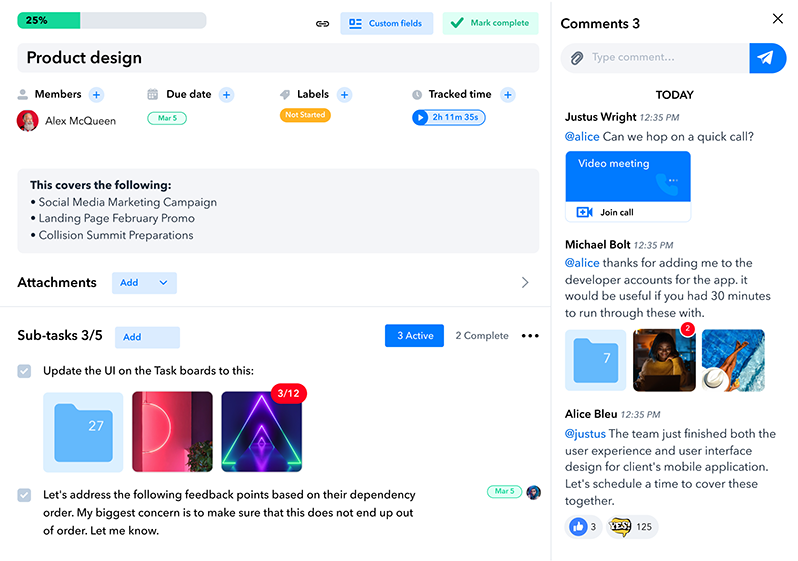At Heycollab, our primary goal is to enhance collaboration and productivity through effective communication and seamless access to key resources. Process management is key to that objective and one of the ways in which we deliver it is by equipping organizations with the right project management tool for process management.
Even among teams and systems used to project management, there could be some confusion between process management and project management. Understanding the differences will help you allocate resources in a better manner and create systems that support the processes crucial to your organization.
In this guide to process management, we will define the concept, explain the differences between process management and product management, and share some best practices.

Heycollab team-chat view
What is process management?
Process management is all about improving the overall efficiency of the different processes within an organization. This requires identifying key processes, reviewing existing methods, working with the stakeholders, and optimizing all steps involved in a process to improve its quality and efficiency.
With a process management tool, you can unearth actionable insights from your processes and find ways to save money and time. It will also help you discover redundancies, however well entrenched they might be in the system, and reduce wastage.
In other words, while improving the output, process management also optimizes the process. This helps you abide by the best practices and avoid mistakes in the future.
How is process management different from project management?
Project management focuses on projects that are important to a company at a given point in time. Whether it’s acquiring new clients, implementing new technologies, or developing new products, project management has a specific goal, budget, and timeline.
It’s for a specified duration and would be rolled out on key projects that have disproportionate effects on the company’s revenue, innovation, or competitiveness.
Process management, on the other hand, isn’t tied to a single goal or limited by a timeline. It’s a continuous method to optimize important aspects of processes within an organization. It doesn’t require any new strategic change in the company. It affects processes that are already within the organization.
Put simply, project management strives to improve the outcome of a particular project. Process management is about improving the existing business operations.
Why you should invest in process management?
Whether you’re an established organization or a startup, investing in process management will benefit your productivity, bottom line, and profitability in these ways:
Improved efficiency
With a process management tool, you will improve your internal systems by discovering inefficiencies and reducing the wastage of resources. This will improve your organizational efficiency. Projects across the board will be completed on time and within budget. Moreover, there will be fewer missed deadlines. This means better client relationships.

Greater agility
Business agility cannot be confined to any single domain or project. It has to be an organizational characteristic for you to adapt to changing market conditions and client preferences. A project management tool for process management will help you review and implement processes to adapt to new situations.
Better transparency
You can only improve business operations if you know where things are getting delayed and where resources are sub-optimally used. Using a process management tool, you will be able to gain real-time information from multiple sources. This is how you better assign resources and bring transparency into your processes.
Higher growth potential
A project management tool for process management will organically reveal blindspots and bottlenecks in the system. By identifying and removing these, you can improve productivity, which will aid in improving your revenue. Importantly, this will help you develop sound business strategies that take into account ground realities.
Increased employee engagement
Are your employees forced to engage in repetitive administrative chores? This can not only bring down their productivity but also affect their morale. With the help of a process management tool, you will discover ways to introduce automation into your processes. This will free up your employees’ time and allow them to focus on value-added tasks.
Promotes innovation
At the core of process management is the belief that no matter how long a process or style of operation has been in a system, it can be reviewed and improved. A process management tool will encourage team members to continuously look for ways to improve the way they work and collaborate. This is how organizations bring in a culture of continuous optimization at all levels.
The stages of process management
These are the five stages that you would find in a process management lifecycle:
Analysis
Before you start using a project management tool for process management, you need to spot processes and identify what needs to be improved. Collecting data on performance metrics will help you spot inefficient processes and roadblocks in the system. You can rely on both quantitative and qualitative methods to collect this data.
Design
At this stage, you’re designing process management with actionable steps for the whole process. This helps you move from the existing state to the desired state. Once you document the steps, you can include further information on various tasks, who would be handling them, and who would be in charge.
Implementation
The execution stage is when the business integrates process management. This requires buy-in from all key stakeholders. You would also need to use technology in the form of a tool for process management. It would be better to roll it out in a phased manner, for example, for a particular team or domain.

Monitoring
For process management to be effective, it needs to be customized for the unique needs of an organization. To begin with, you need to collect data during the trial period. Talk to team members and managers to see how the process has affected them. Once you integrate their feedback, roll it out, and monitor key metrics to see if the larger goals are being met.
Optimization
After process management has been implemented in the system, you must keep exploring opportunities to optimize it. New technologies such as automation may have to be introduced in several processes. Also, internal and external factors might necessitate changes and you may have to design new processes to accommodate these.
How a project management tool can help you in process management
To reap the fruits of process management, you need a tool that’s user-friendly, advanced, and intuitive. The right project management tool for process management can help your organization in these ways:
Standardize repetitive tasks
There are several repetitive tasks in an organization that can be standardized with a process management tool. This reduces errors and gives people more time to focus on their core tasks. Developing a marketing plan, for example, can be standardized easily with a process management tool.
Another area is onboarding. When you have a tech-enabled process management tool, you can more effectively onboard people without having to reinvent the wheel every time. Heycollab allows you to duplicate tasks which will save you time and make your employees more productive.
Improve existing processes
Why look for the latest fad in management when you can focus on enhancing your existing processes? With a process management tool, you don’t have to worry about creating anything new that would take up more time and resources. You can improve the quality of your current processes and get them to be more optimal and effective.
With Heycollab, you can create templates to make process management even easier. This helps you manage deadlines and workloads while focussing on the main task at hand.
Smartly allocate resources
A key aspect of process management is assigning ownership to individuals and empowering them with the necessary resources. Manually doing it can be cumbersome and slow down business operations. A project management tool for process management uses technology to speed up the process.
With Heycollab, you can organize tasks and resources and quickly view not just your tasks but also those of your team members. This enhances collaboration and productivity since you don’t have to send emails back and forth or have unnecessary meetings.

Create a culture of improvement
The biggest benefit of using a project management tool for process management is that you will instill a culture of continuous improvement in your company. This is true for both established firms and startups. The default mode in both sets of firms is to follow the norm.
In established firms, there’s no incentive to question the effectiveness of processes simply because that’s what everyone has been doing for decades. In startups, there’s little evidence to favor one over the other. Whatever works in other firms or is currently helpful becomes the standard process.
By unearthing inefficiencies, a process management tool will reveal the potential for improvement. Once it’s backed by data, it would be difficult for stakeholders to question it. Since you’re working on existing processes, this continuous improvement will also save you time and money.
In other words, with a process management tool, you always look for opportunities to improve the way you create and collaborate.
————-
If you’re looking for a productivity management tool designed for teams, you can enhance your team’s performance with a tool tailored to their needs. Heycollab has many features – docs, chat, calls, time tracking, and more. Your workflow will be smoother and more efficient. Sign up now to experience the ease that Heycollab brings to collaboration and productivity!

